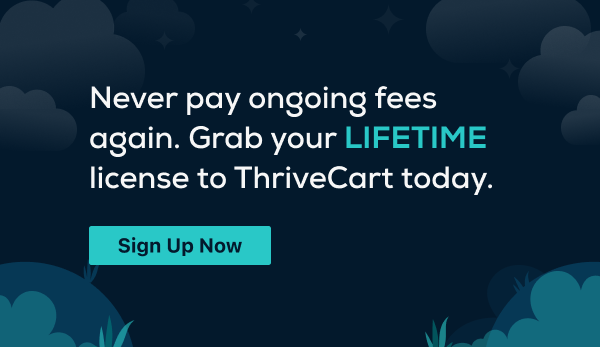SEO: love it or hate it, it’s still an essential part of success in online business.
You’ve optimized your website, your product descriptions and even your social media: but have you SEO optimized your cart pages?
It’s easy to overlook this end-of-the-journey page when it comes to SEO, but the bottom line is that optimizing your cart pages could make or break the sale – and potentially lead to further profits.
Cart pages are a critical part of sales funnels. Optimizing them for search engines gives you the very best chance at success: and we’ve compiled this handy-dandy guide to help you make the most of the opportunity.
| Did you know? ThriveCart gives you everything you need to optimize your page for SEO, including meta descriptions, favicons, page titles, and more. |
68% of online experiences begin with a search engine, according to Ahrefs. Bear in mind, when it comes to SEO you’re not just making it easier for search engines to index your pages: these principles make pages easier to read and use for humans, as well. That means you’re making it easier for customers to make a purchase.
A Brief Introduction to SEO
Before diving into the specifics of cart page SEO, let’s briefly review what SEO is and why it’s essential for your e-commerce site.
SEO is the process of improving a website’s visibility on search engines like Google, Bing, and Yahoo. It involves optimizing various elements on your website to rank higher in search engine results pages (SERPs). When your website appears higher in search results, it attracts more organic (non-paid) traffic, which can lead to increased sales and revenue.
SEO involves several techniques and best practices, including optimizing on-page elements, creating high-quality content, building backlinks, and improving site speed and user experience.
Back in the day, so-called black-hat SEO techniques developed that aimed to trick search engines like Google into boosting them up the rankings. This involved keyword-stuffing, hiding links, and sneaky redirects. Not surprisingly, no page worth its salt does this anymore: not only do they not work, they actively harm your reputation and increase the risk of getting your pages penalized in the search engine results.
In short, search engines want to return the best results for readers. That means optimizing your page for SEO is the same as making it better for humans. Every time Google releases a new algorithm, it does so with the aim of improving its service for the people who use it: so there’s no point in trying to “trick” it when simply improving your page for human readers will work.
Optimizing your cart pages for SEO means:
- Adding a descriptive page title
- Writing a meta description that isn’t too long
- Adding a social image for when your page URL is shared online
- Allowing search engines to index your page
- Optimizing for mobile and other devices
- Including testimonials and guarantees for social proof
While most e-commerce businesses focus on optimizing product pages and blog posts, cart pages are often overlooked. However, they play a crucial role in the conversion process. Let’s dive into why that is.
Does SEO Even Matter on a Cart Page?
Yes! Cart pages are the final step before customers make a purchase with you. They are the final gate, the end goal: cart pages display the items customers have selected, reminding them of the brilliant things they have in store. On a cart page they can review their order, weigh up any second thoughts or hesitations, and (hopefully) proceed to the checkout stage.
In short, the cart page is vital because this is where purchasers are in danger of abandoning the whole sales process altogether.
While cart pages may not seem like a primary focus for SEO, several reasons make them important:
- Visibility: Cart pages can appear in search results, especially if customers use specific search queries. Optimizing cart pages increases the likelihood of them showing up in search results, providing another entry point for potential customers.
- User Experience: SEO is not just about search engines; it’s also about improving the user experience. When cart pages are optimized, they are more user-friendly, making it easier for customers to review their orders and complete the sale.
- Credibility: An optimized cart page reflects professionalism and trustworthiness. When customers see a well-structured and informative cart page, they are more likely to complete their transactions, and come back for more. You should never treat your cart page as an afterthought!
- Conversion Rate Optimization: By incorporating SEO best practices on your cart pages, you can help improve conversion rates. When customers can easily find their carts and navigate through the checkout process, it reduces cart abandonment rates: boosting your CRO.
Now we know a bit more about what SEO is and why it’s important, let’s delve into the best SEO practices specifically tailored to cart pages.
The Best SEO Practices for Cart Pages
There’s no one-size-fits-all solution when it comes to search engine optimization. Cart pages are no exception: in fact, there’s some very specific things you need to keep in mind when optimizing cart pages.
All of these options are available for you to fully customize in ThriveCart, giving you the opportunity to make your pages as SEO-friendly as possible, right from the start.
1. Page Title
Page titles are one of the most critical on-page SEO elements. For cart pages, the page title should be concise, descriptive, and include relevant keywords. On cart pages, this should clearly indicate that the page is the shopping cart or checkout page.
Best Practices:
- Include the words “Shopping Cart” or “Checkout” in the title.
- Use your brand name or product name (if you only have one).
- Keep it under 60 characters to ensure it’s fully displayed in search results.
Example: “Your Cart – BestWidgets Online”
2. Favicon
A favicon is the teeny-tiny icon displayed in the browser tab when a user visits your website. While it may seem minor, it contributes to your website’s branding and recognition. Having a unique and memorable favicon can make your site stand out in users’ browsers.
Best Practices:
- Create a favicon that represents your brand, such as a simplified version of your logo.
- Ensure the favicon is square and easily recognizable, even at a small size.
- Bonus points: incorporate a cart or basket with your logo to specify that this is a cart page.
3. Page Description (or Meta Description)
The page description, also known as the meta description, is a concise summary of the page’s content. While it may not directly affect rankings, it plays a crucial role in enticing users to click on your cart page when it appears in search results.
Best Practices:
- Write a brief, compelling description that informs users about the contents of the cart page.
- Include a call to action (CTA) to encourage users to proceed to checkout.
- Keep the description between 150-160 characters to ensure it’s fully displayed in search results.
Example: “Review your items and complete your purchase. Checkout now and enjoy free delivery!.”
4. Testimonials and Guarantees
Integrating social proof elements into your cart page can enhance its SEO performance by increasing the likelihood of people buying from you. By putting testimonials, user reviews and any guarantees you offer up front, you’re communicating clearly that your product is trustworthy and that other people love it – so they will, too!
Best Practices:
- Keep user reviews and testimonials short and sweet. If possible, include a picture of that person for extra social proof (people tend to trust faces).
- Adding a 30-day money back guarantee is a great way of making sure your buyers feel like their money is in safe hands, and that you believe in the product you’re selling.
5. Search Engine Indexing
By default, cart pages on e-commerce platforms may not be indexed by search engines. However, it’s essential to ensure that your cart pages are indexable. This allows search engines to crawl and include them in search results when relevant.
Best Practices:
- Check the “Allow search engines to index?” box in your ThriveCart page’s SEO settings, available in the editor.
6. Social Share Images
Setting a social share image makes your page look much better when people tell others about it. This is the image that’s pulled through when sharing your checkout URL on popular social media platforms, such as Facebook or Threads. Granted, it isn’t often people choose to share their cart pages, but you never know!
Best Practices:
- Upload a social media share image in ThriveCart in your page’s SEO settings, available in the editor.
- Use your logo, product image (if you only have one), or a stock image of a cart or basket.
7. Optimize for Mobile
Finally, your cart needs to be optimized for mobile access. According to Statista’s Market Insights, mobile e-commerce sales reached $2.2 trillion in 2023 and now make up 60 percent of all e-commerce sales around the world. Making your page easier to use and faster to load on mobile is absolutely crucial when it comes to securing a successful sale.
Best Practices:
- Use ThriveCart to ensure your cart pages look gorgeous on mobile: our mobile versioning is top notch, allowing for automatic optimization.
- Keep in mind different screen sizes, and don’t make your pages too long so that users have to scroll all the way to the bottom to make their purchase.
Cart SEO is Important (and You Have All the Options You Need on ThriveCart)
Optimizing your cart pages for SEO is a crucial aspect of improving your e-commerce website’s performance and increasing conversions. Cart pages serve as the final touchpoint before customers complete their purchases, and by following the best SEO practices outlined in this guide on your cart pages, you can:
- Improve the visibility of your cart pages in search engine results.
- Enhance the user experience, leading to reduced cart abandonment rates.
- Boost your website’s credibility and trustworthiness.
- Potentially gain higher conversion rates and revenue.
Not all e-commerce platforms allow you to change your cart page’s SEO options: but with ThriveCart, it’s easy. We know how important search engine optimization is for your brand, and that’s why we include all the options you need to make your SEO a success.




